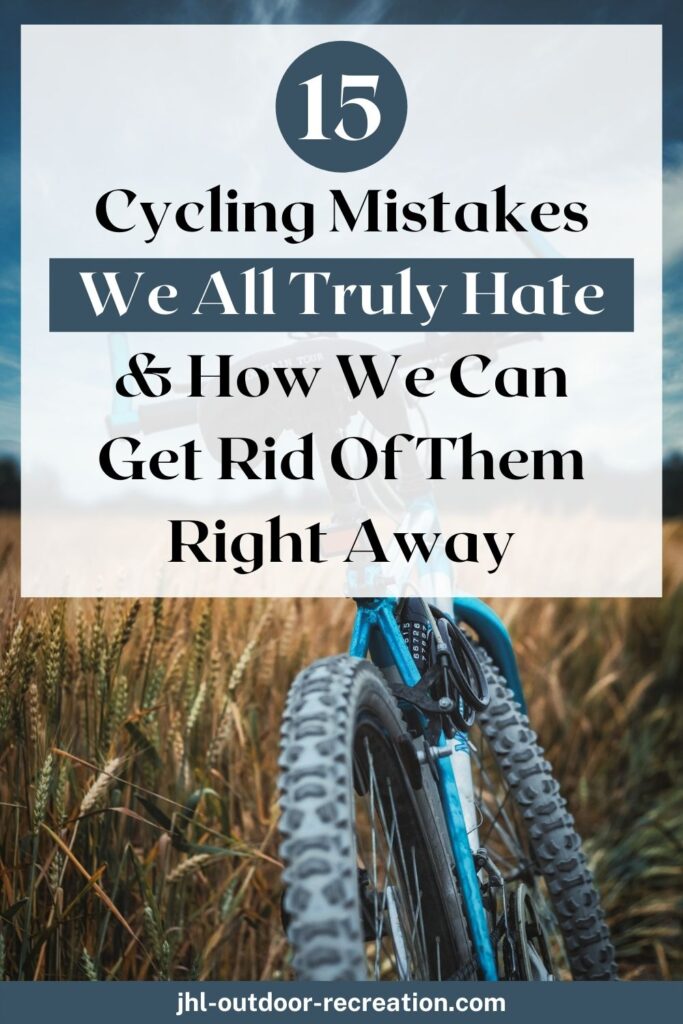No one is perfect. As human beings, we are bound by making mistakes, even for simple or mundane tasks. Speaking of cycling, we might be making some mistakes even without noticing.
Don’t feel bad if you are a beginner who think you might be making tonnes of them. Well, pro cyclists could have these mistakes even they are completely aware of these. That’s because they can’t break their habits.
Ok, fine. So, you might assume where we make these mistakes WHILE we are cycling. The truth is, we might make mistakes even BEFORE we are cycling.
So, let’s talk about top 15 biggest cycling mistakes for any types of cycling.
Why do these matter? Certainly, we want to fix them before we form bad habits! If not, it is even harder to break the habits to correct the cycling mistakes!
1. Not wearing helmet
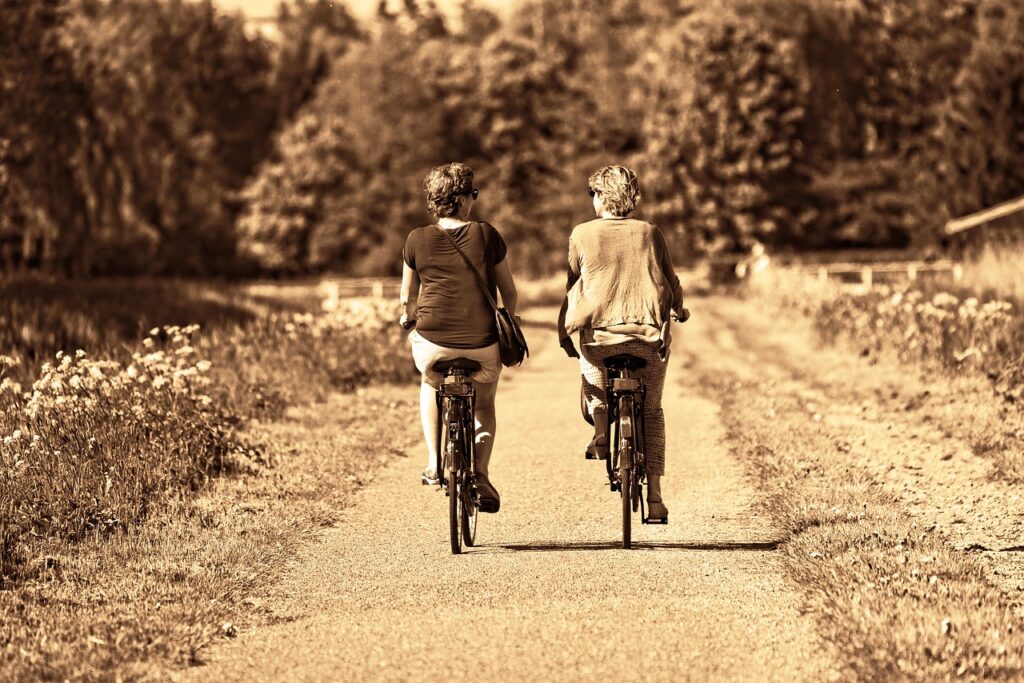
Perhaps this is the most crucial amongst the cycling mistakes.
Ok. I understand where most countries do not mandate wearing bike helmet for cycling. So, we are legally right not to wear a bike helmet.
Here’s a thing. Motorcyclists need to wear helmets when riding motorbikes. This is mandatory. And the reason is obvious. That’s to protect their heads and avoid head injuries if accidents happen.
Cycling is no different from riding a motorbike. Logically, we SHOULD wear bike helmets whenever we are cycling. – What is permitted by law doesn’t mean we don’t have to do this.
How to fix this
Get a bike helmet.
And that’s not enough. You should get a RIGHT bike helmet that truly fits you. Only a right bike helmet can protect our head when an accident happens.
There are some FACTORS to consider when choosing the right bike helmet, such as:
- Purpose and occasion
- Types of helmets
- Safety standard
- Ventilation
- Retention system
- Weight
Before that, I had written a post on how to choose the right bike helmet. You can refer to that for better understanding.
2. Not knowing hand signals
When we drive, we need to give signal to other road users as a way of “communication”. For example, we signal before we turn; we switch on emergency light if we need to stop at the roadside……
And these are to avoid accidents!
Same goes for cycling on the road. Don’t assume we don’t have to “communicate” with other road users as bikes don’t have any signal device.
Clearly, we need to use hand signals. If you have driving license, these shouldn’t be strange to you, because they are part of the traffic rules. – Motorcyclists need to learn this.
Besides, hand signals are also important for group cycling. These help communicate among cyclists. And you don’t want to be clueless when cycling in group, right?
How to fix this
Learn or be familiar with hand signals.
Hand signals have 2 purposes, ie. maneuvering and showing obstacles.
For maneuvering, get to know the basic:
- Turn left – extend the left hand to the left
- Turn right – extend the right hand to the right. Or, lift the left hand and bend the elbow perpendicularly upwards.
- Slow down – gently flutter the palm (either hand)
- Stop – lift the hand (either hand) and bend the elbow perpendicularly downwards
Remember to look over your shoulder to check when maneuvering.
For showing potholes or obstacles, simply point to the direction of the obstacles.
3. Don’t follow traffic rules
This could be the biggest misconception for road cycling. Some cyclists think they are “invisible” on the road as the bikes are “small”. – Well, bikes don’t really occupy space.
Plus, many traffic rules have grey area for cycling. So, they could ignore traffic rules without being caught. For example, ignoring traffic lights; riding above speed limit, etc.
These increase the risks of accident.
Even when they get fined / ticket, they could argue that they are “legally” right. Well, who is here to blame?
How to fix this
Change the mindset. Treat cycling as the same as driving on the road. Follow traffic rules.
The size of the bike and the loopholes of traffic rules don’t exempt us from observing traffic rules.
Even pedestrians, who don’t drive or ride per se, need to follow traffic rules. So, how on earth do cyclists have this privilege? – Do you agree with this?
4. Improper saddle height
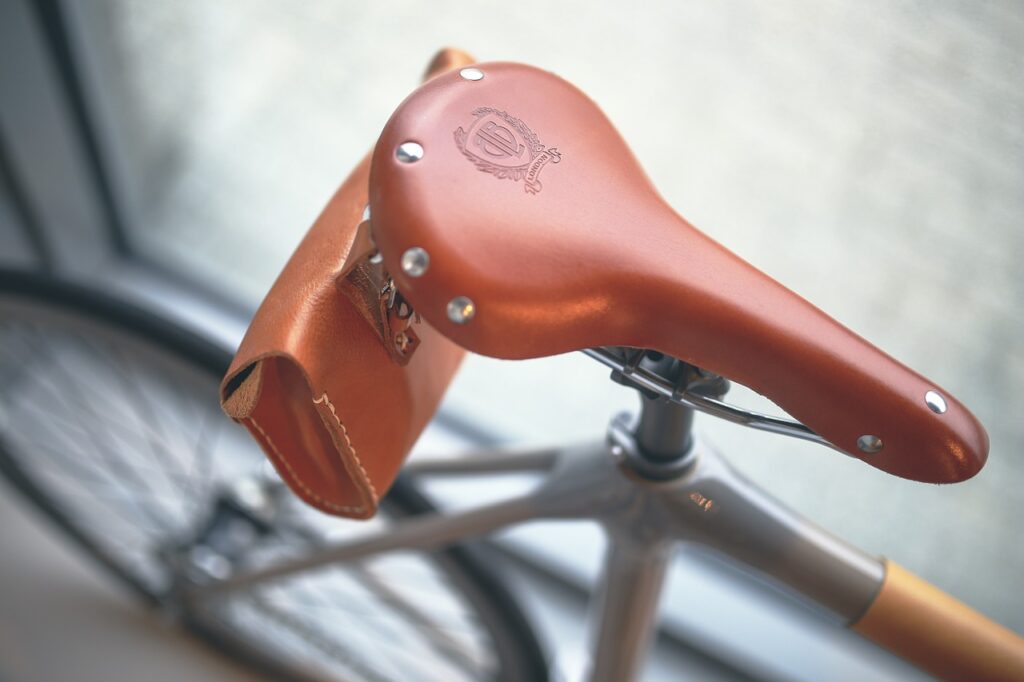
I remember when I got my first bike, I just hopped onto the bike and started cycling.
The saddle height seemed not quite right for me. But, I didn’t know how to adjust it. So, I just pedaled without bothering the saddle height too much.
Does this sound familiar to you?
Well, it turns out that the saddle height could be too “high” or too “low” for us.
Eventually, we get used to the height and we might think it won’t cause any problem to pedaling.
But, the problem persists whenever we are cycling. Improper saddle height compromises cycling efficiency. And it’s not comfortable, even we already get used to it.
How to fix this
To get a proper saddle height, our legs should be ALMOST straight, not fully straight, when pedaling.
This seems ideal. But next issue arises. “Almost” is vague, as any position could be “almost” straight.
To address this, sit on the saddle and extend your leg. Your leg should be straight when your HEELS are on the pedals.
Bear in mind that this posture is just a way to find the right saddle height. That’s because we pedal on our FOREFEET, not heels. This posture makes sure that the height is just nice when we pedal.
So, you need to adjust the saddle accordingly until you reach this optimal height.
5. Riding without checking
Time is important to us. Every second counts, especially living in cities.
So, we tend to mount the bike straight and start cycling. While it seems perfectly fine in most settings, we might face some problems if odds happen.
It turns out where the tyres are flat or punctured. Worse, we only discover this while riding for quite a while. There’s no pump to inflate the tyres. Or we might need to change the punctured tyres. – Only if we have the spares with us.
Or, the chain makes some weird noise. Ah, we forget to lube the chain. This explains the noise.
Although we might continue riding, we use extra energy to ride the bike. This is not efficient. And we get tired easily.
How to fix this
Spend some time, say 1 minute, to check the bike condition before cycling. Check the brake, tyres, and chain to see if everything is fine.
If it’s fine, that’s great! You spend that 1 minute to get comfort.
If otherwise, spend additional time, maybe 5 to 15 minutes to fix the issues. For example, inflate the tyres or lube the chain.
You get a nice ride by spending a few minutes beforehand to check the condition. You don’t have to face any mess during your ride. – Don’t you think it is worth?
Also, this is part of maintenance routine. Meaning, you maintain your bike and save money for replacement.
6. Brake too hard
I believe you experience before.
When you are driving, there is a driver in front of your car who constantly presses the brake pedal even on a straight road.
The driver even has emergency brake without any reason! That absolutely shocks you and you also do so to avoid collision.
It turns out that the driver is too cautious when driving, and he keeps pressing the brake pedal too hard.
Don’t be surprised as there are cyclists who also brake too hard. Well, they could be new to cycling or too tense. They can’t control the brakes.
Don’t underestimate this because braking too hard could be horrendous.
Firstly, it could lead to collision, just like the above. Secondly, the cyclists are “pushed” forward, which could lead them fall down from the bikes.
How to fix this
Just like pressing the brake pedal when driving, be Slow and Steady.
Don’t press the brake abruptly, unless you really need emergency brake.
Next, if there are both front and rear brakes on your bike, this is for you.
Know the location of both front and rear brakes. While most bikes follow “Right for Rear, Left for Front” principle, don’t assume all the bikes follow this.
Depending on the regions or countries, the location of both brakes can be switched.
Hence, you need to verify by testing on your own.
Once you are clear with this, get to know the purposes of each brake. Generally, rear brake is for slowing down the speed, whereas front brake is for sudden / emergency brake.
Bear in mind for a sudden brake, you should lean your body BACKWARD to counter with the inertia of your body. So, you won’t lose balance and fall down from your bike.
7. Wrong gear
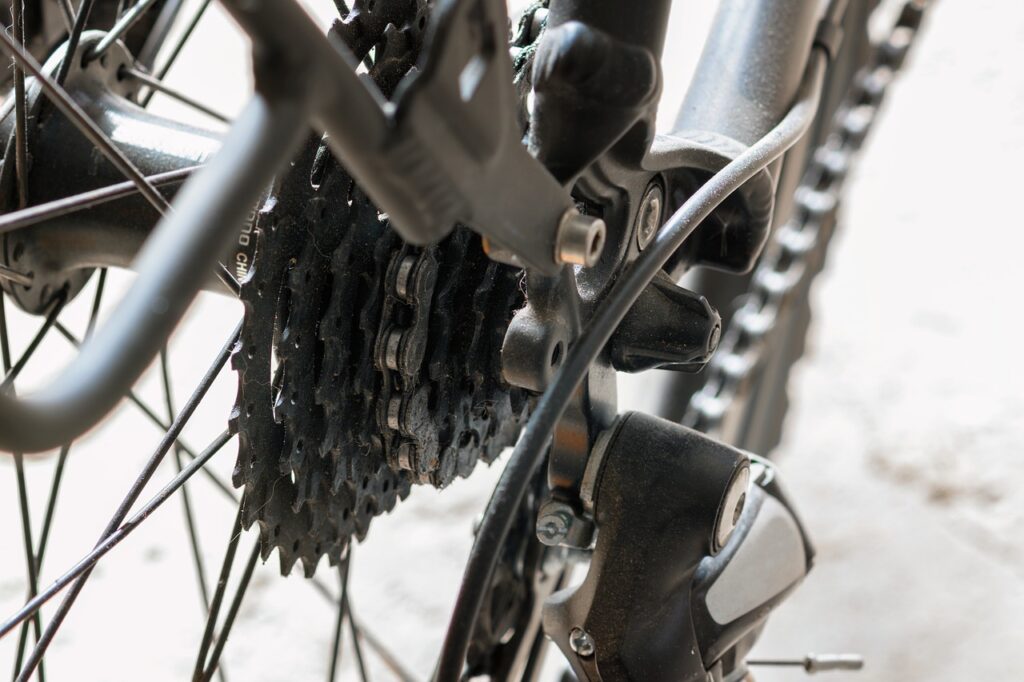
Riding uphill is truly a nightmare. It is damn hard to pedal uphill.
We get exhausted and start to catch our breath. Our sweat drips. Still, it feels like gravity always wins!
So, our instinct tells us to pedal HARDER. But, the harder we pedal, the more exhausted we are. – Is there an efficient way to ride uphill?
We might even forget to do one thing. That is, to change to the right gear.
Generally, high gear is for riding downhill or on flat surface; low gear is for riding uphill.
Just like the scene above. If we suffer riding uphill, chances are we are using high gear. We waste too much energy. And that’s why we are tired and out of breath.
Likewise, using low gear for riding downhill isn’t ideal, either. Yes, it’s not exhausting, but it’s inefficient. And other cyclists overtake you easily…..
Imagine driving a manual car. Pay attention to the engine sound when pressing the accelerator pedal too hard on low gear. Likewise, feel the car when driving uphill using high gear.
After all, efficiency is what we need, whether driving or cycling.
How to fix this
Most bikes have gears. The purpose of gears is to ensure cyclists to ride comfortably in all settings.
Firstly, get to know the components of gearing system. Depending on the design of your bike, your bike can have:
- Cassette: Collection of different sizes of rear cogs
- Chainrings: Collection of different front gear, particularly either 1, 2, or 3 chainrings
- Shifters: Components, attached on the handle bars, which allow you to change gears when you press it
- Derailleur: Components installed along with the cassette and chainrings to enable changing of gears when the shifters are pressed.
Secondly, understand how gearing system works. To switch to high gear, switch the chain either to bigger chainring or to small cogs. – Meaning, move the chain OUTWARDS.
Conversely, to switch to low gear, switch the chain either to smaller chainring or to bigger cogs. – Move the chain INWARDS.
Remember to be familiar with the gearing system so you know how to change to suitable gear in every setting.
In fact, this is not the end of the story. This might lead to cross chaining and we will also discuss this below.
8. Cross chaining
Alright. We know how to change gears. And we can further explore the gearing system.
We might notice we can switch the chain to 2 extreme positions:
- Biggest chainring and cog
- Smallest chainring and cog
These are what we call “cross chaining”. Yet, we can still ride our bike just fine.
If you asked any biking experts or pro cyclists, they might tell you not to cross chain if possible.
So, what’s the big deal?
Cross chaining refers to the chain not in neutral position. The position is “skewed”, which the chain rubs against the derailleur / cog / chainring when pedaling.
In fact, cross chaining doesn’t only refer to the 2 extreme positions. It can cause cross chaining as long as the chain position isn’t neutral. Meaning, even positions within the two extremes can cause this.
The possible impacts include:
- Big chainring and cog – the chain and derailleur sustain too much stress. The chain rubs against the derailleurs and produces noise.
- Small chainring and cog – the chain is too lose, which might cause the chain totally derail. The chain rubs against the cogs and derailleurs and produces noise.
So you already know the damage to your bike, right? You might need to spend money to replace them if you cross chain too much. Besides, cross chaining is not efficient in cycling.
How to fix this
Among other cycling mistakes, I believe this is the most technical.
Always make sure the chain is in neutral position, even when changing gears.
With that being said, you need to use both front and rear brakes, not only rely on either one of them.
Know the location of shifters. The location of front and rear gears should be the same as brakes’. Again, verify on your own.
To avoid cross chaining, rightfully the size of both cogs and chainring are RECIPROCAL.
If otherwise, you might hear squeaky sound from the chain. Depending on the gear you want to change to, press the left or right shifter and make sure the chain returns to Neutral position.
Cross chaining and wrong gear are quite technical cycling mistakes. This means you may need to spend some time to fix them.
Or, there is another option for you. If you ride on a flat surface or road, get a SINGLE speed bike. You don’t have to worry about wrong gears and cross chaining, at all.
FYI, Cycling Weekly has a detailed post on bike gears and cross chaining. I urge you to check the post out.
9. Improper clothing
We might not even care what we are wearing when cycling.
In the end, we could be sweating excessively. Or, we could also be shivering under the freezing weather despite vigorous cycling.
Cycling under the rain is the worst. Literally we don’t have a rain jacket. We are either soaking wet or we have to stop to wait for the rain to stop. – Waste our time.
In other words, we wear improper clothing for cycling.
How to fix this
Well, it doesn’t mean we have to wear like those pro road cyclists or mountain bikers.
Wear for the weather is all you need for cycling. This applies to ALL types of cycling, including bike commuting or cruising riding.
Before you get to your bike, remember to check the weather if it is cold or warm. If the weather is warm, a T-shirt is enough for you.
If the weather is cold, you definitely need a jacket or to wear in layers.
But, if you are unsure about the weather, better wear more than fewer, because you can take them off if you feel hot when cycling.
By checking the weather, you also get to know whether it will rain or not. If this is the case, you can consider a few options:
- Stay at home – well, who likes to ride under the rain?
- Other options – eg. driving or taking public transport
- Go ahead – and you may need a rain jacket or a poncho
10. Eat too full

Yes, I know. Cycling is an exercise. So, we need energy to work out. The longer the ride is, the more energy we need.
But, some people take this too seriously. They eat too full before cycling so they have enough energy.
But, they might face some problems. They can feel dizzy and nauseous. The harder they ride, the stronger the feeling is. Worse still, they might throw up.
It’s not hard to know this. After a heavy meal, blood goes to our digestive system. This reduces oxygen concentration. Hence, we feel sleepy.
And if we exercise vigorously, this further depletes oxygen level. So, these symptoms show up.
How to fix this
If you only ride for short distance and leisurely, you don’t have to worry about this.
But, if you need to ride for speed or training, then this one is for you.
Avoid having heavy meal before your riding session, at least 2 hours. You don’t have to refuse to eat, either.
All you need is to have light meal during this period.
For bike commuter, you can consider splitting the meal into 2 sessions. Eat before and after cycling.
11. Not going to bathroom before riding
Do you remember where you were driving on highway, and you suddenly needed to pee or poo?
You started to panic because there was no bathroom. So you sped up to hope that you could reach home before it leaked.
It’s always our nightmare, isn’t it?
Since we can have this while driving, this can also happen for cycling.
Sometimes, we have the urge to pee or poo before we ride. But, we choose to ignore it as the urge is weak.
But, the sensation gets stronger while we are riding on the road. Yes, we can stop and look for a bathroom to settle. However, it’s not always the case.
You could no longer focus on cycling. All you want to do is to finish ASAP so you can go back to use the bathroom.
How to fix it
Don’t resist the urge. Use the bathroom first. It’s better to be late for a few minutes than having to deal with the mess while cycling. It will screw you up.
Or, if you need to ride for a few hours non-stop, you can use the bathroom first, although you don’t have the urge yet. – Who knows you might need to while cycling and this drags your schedule?
Lastly, you definitely need to avoid drinking too much of water. You might need to pee before your cycling training session.
12. No warming up
Sadly, this is the most forgettable one among these cycling mistakes.
Many of us don’t even treasure its importance. It’s a general knowledge to warm up before any workout. Cycling is a workout, too. So, we need to warm up before cycling.
But the truth is, we CHOOSE to ignore this. We think this is redundant because we treat riding as part of our warm-up session.
Yet, we feel tightness in our leg muscles. So, we use more energy to ride. We get tired faster. The next day morning, our leg muscles are sore.
How to fix this
Apart from the riding warm-up session, we still need a pre warm-up session.
That is generic stretching. Spend 5 to 10 minutes to stretch the whole body to improve blood circulation and muscular movement.
13. No sunscreen
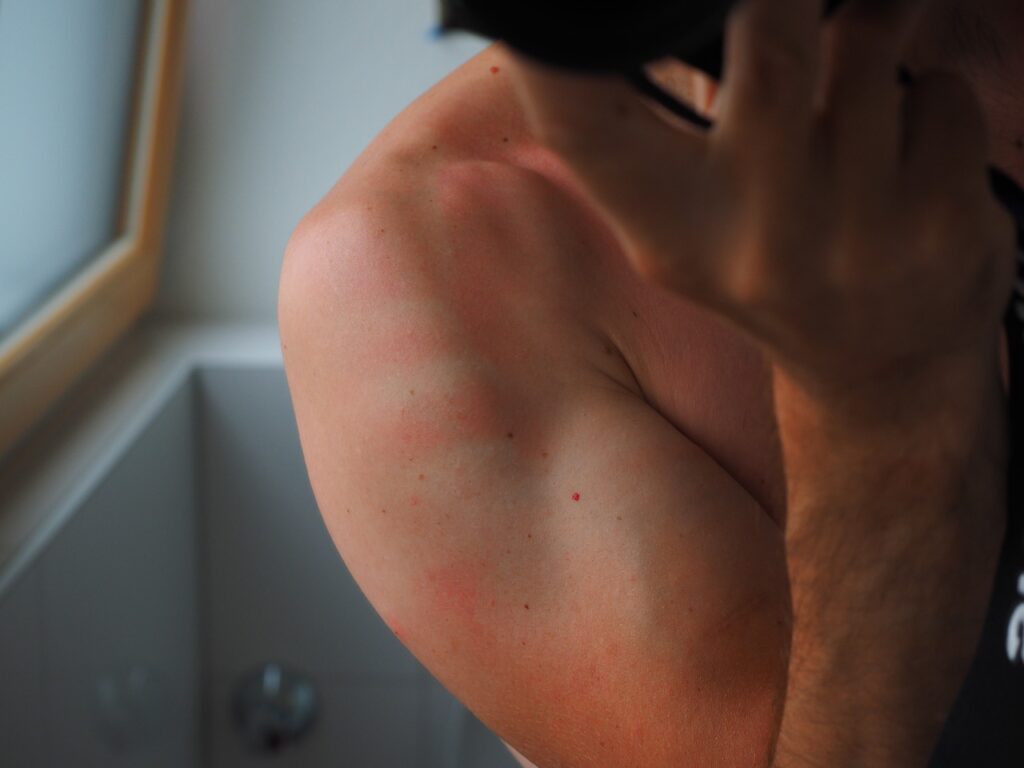
Let me tell you a secret. I admire those pro road cyclists wearing the trendy cycling outfits. In contrast, I find one thing quite amusing from them.
That is the deep TAN LINE. I wonder if they apply sunscreen.
Alright, this doesn’t only apply to road cyclists, but to all cyclists cycling under the sun.
The tan line is unpleasant as it makes us look like an uneven roasted chicken. And it takes months to vanish.
To make it worse, this might cause skin cancer if we don’t take care of our skin.
How to fix this
Clearly, apply sunscreen before riding under the sun. Just like what we do when we have sunbathing at the beach.
Although it might not totally avoid tan line, it can still weaken it. Most crucially, it protects our skin from exposing UV light excessively.
14. Too hard too soon
You are having a training with your cycling mates. The day is beautiful. Cool and sunny. And you are full of energy. Everything is perfect.
Without further ado, you speed up pedaling and outpace your mates. You feel excited and you like this feeling.
Nice thing doesn’t last long, though. You start to get out of breath. Your are getting slower. So, you pedal harder but your thighs don’t “listen” to you.
The rest is just too tiring as you burn out your energy too fast. Meanwhile, your mates outpace you with ease……
Finally, you realize you didn’t warm up and preserve energy properly. All you did is let your emotion control you.
How to fix this
Don’t get hyped and straight speed up without proper preparation.
Your body needs time to adjust. That’s why you need to warm up your body before that.
But, your body is not ready for the vigorous cycling yet. Start slow and stay at steady and comfortable pace, until your body is ready.
Just like how Keirin works. Cyclists follow pacer’s “easy” pace before they sprint for the remaining laps.
15. No snacks OR water
Ok. We get that eating too full before cycling doesn’t bring any good. So, we choose to ride on empty stomach.
Nonetheless, we start to feel hungry and thirsty when we ride quite for a while. Yet, we might make the fundamental mistake for cycling. – We forget to bring snacks and water!
So, you might face any one of these:
- Get from other mates – but you don’t expect them having “yeah, sure” expression on their faces
- Stop by any grocery to get them – you waste your time searching for that
- Keep going without snacks and water – and with your empty stomach
How to fix this
With that being said, not only does this apply to road cycling, but also applies to any types of cycling, especially bike commuting.
You need some light snacks and a bottle of water with you.
When you are hungry or thirsty, try to STOP cycling and have your snacks and hydrate, unless you are on a race or training.
Final thought: biggest cycling mistakes
These 15 biggest cycling mistakes aren’t hard to fix, are they?
Well yeah, except for the brake and gear parts, which we might take some time to master them to fix these cycling mistakes.
It doesn’t matter what types of cycling we have, we may make these mistakes without noticing. – Be it commuting, cruising, road cycling etc.
After all, we need to be AWARE of these cycling mistakes and put in little effort to FIX them. Gradually, we form good cycling habits.
Relevant posts
